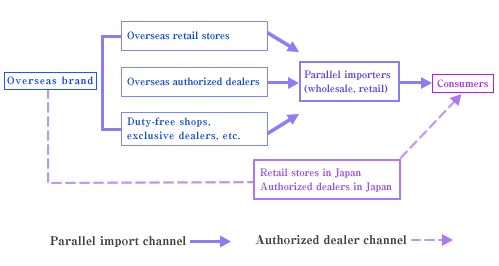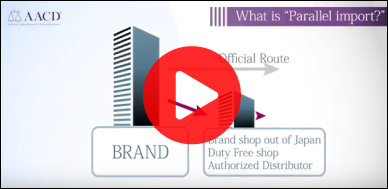1. What is Parallel Importing?
There are basically two channels for importing brand products to Japan. One is the authorized dealer channel, whereby products are imported via authorized dealers in Japan. The other channel is the parallel import channel, through which genuine products sold abroad are directly purchased abroad and imported to Japan. The latter is a legal business transaction which has been approved by the Japanese Ministry of Finance in 1972 and by a number of court precedents.
Japan’s anti-monopoly law also acknowledges the role of parallel importing in promoting free competition in the market.
Parallel import channel and the authorized dealer channel

2. Parallel Import Issues in Japan
1965
Around this time, the parallel importation of genuine brand products was regarded as a trade act that infringes on the rights of local trademark holders. However, aside from blatantly obvious cases of rights infringement, imports were scrutinized and judged only when an appeal for suspension of importation was accepted by the relevant authority.
1970
In the Parker case, the Osaka District Court ruled that, under certain conditions, “the parallel importation of genuine products does not constitute an infringement of the rights of local trademark holders.” This was the first time that parallel importation was judged as “lacking substantial illegality.”
1972
The Customs and Tariff Bureau of the Ministry of Finance issued an official notice stating that the parallel importation of genuine brand products is “an act which does not infringe on trademark rights.”
1985
The signing of the Plaza Accord by the G5 brought about a rapid appreciation of the yen against the dollar and prompted a drastic increase of imports.
The yen appreciated from 235 to 120 yen against the dollar, and nearly doubled its value in a year. Thereafter, the so-called “bubble economy” gave rise to a boom in Western brand products in the Japanese market.
1989
Commodity tax was abolished with the introduction of the consumption tax. This prompted a reduction in domestic sales prices of fountain pens, lighters, and other luxury products which were subject to high taxes, as well as narrowed the disparity between domestic and foreign prices. As a result, fashion items such as clothes and shoes gradually became the mainstream in the parallel import market.
1998
Toward the end of the 20th century, the “mega brands” flourished, and the market for Western brands is reported to have reached its peak during this period. Prada was one of the most popular brands in the market, but the circulation of large quantities of counterfeit Prada goods became a social problem.
The Prada case opened people’s eyes to the fact that large quantities of counterfeit goods are being sold in the guise of parallel imports, and underscored the necessity of taking measures to protect intellectual property rights in the parallel import market. With the realization, however, that fraudulent products cannot be eliminated through the efforts of individual companies alone, the Association Against Counterfeit Product Distribution (AACD) was established in April 1998.
2000
Around this time, famous Western brands began to put in motion their global strategies, strengthening direct sales channels and standardizing retail prices. For instance, LVMH Moët Hennessy – Louis Vuitton launched an Internet sales channel in the United States in 2000.
Japan saw the resurgence of the “brand boom” even amid its economic recession, and the famous brands were back in great demand. Flagship brand stores opened one after the other, and consumers literally snapped up brand products at parallel import shops and recycle shops alike.
2003
In 2003, the Japanese Supreme Court ruled for the first time that the parallel importation of products that satisfy a three part test—identity of trademark, identity of origin and identity of quality—“lack substantial illegality.” This was the famous ruling of the Fred Perry case.
